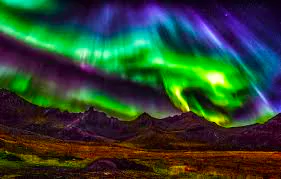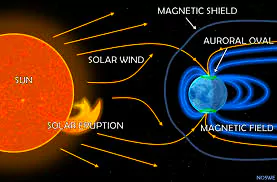Context

Auroras lights were imaged by the astronomers of the Indian Institute of Astrophysics, Bengaluru (IIA) through an all-sky camera positioned around the Indian Astronomical Observatory (IAO) in Hanle, Ladakh.
- Auroras are also witnessed in other parts of the world, including in the United States and the United Kingdom, Russia etc, while southern lights (aurora australis) were spotted in countries such as New Zealand and Australia.
About Auroras
Auroras are bright and colorful lights, formed due to an active interaction in Space between charged solar wind particles and the Earth’s magnetosphere.
- As the solar wind approaches the Earth, it is deflected by the planet’s magnetic field, which acts like a protective shield.
Enroll now for UPSC Online Course
Explained: Key Terms
- Solar winds: they are ejections of charged particles from the Sun’s atmosphere, mostly composed of protons and electrons.
- The magnetosphere: It is the magnetic field region surrounding the Earth protecting the Earth against solar winds and is strongest at the poles.
- Coronal Mass Ejections (CMEs): They are large expulsions of plasma and magnetic field from the Sun’s corona. They can eject billions of tons of coronal material and carry an embedded magnetic field
- The fastest Earth-directed CMEs can reach our planet in as little as 15-18 hours.
|
- However, some of the charged particles are trapped in the magnetic field and they travel down the magnetic field lines at the north and south poles into the upper atmosphere of the Earth.
- Interaction with atmospheric elements: These particles then interact with different gasses present in the atmosphere resulting in tiny flashes of light in the night sky.
- When solar wind particles collide with oxygen, a green colour light is produced. Interaction with nitrogen produces shades of blue and purple.
- Example: How electrons flowing through gas in a neon light collide with neon and other gasses to produce different colored light bulbs.
- Traditionally viewed: Auroras are usually seen in high-latitude regions of North and the South Pole all year round.
- The phenomenon is known as the northern lights (aurora borealis) in the Northern Hemisphere and the southern lights (aurora australis) in the Southern Hemisphere.
Aurora Lights in India, Why are auroras visible from Ladakh?
- Heightened solar flare activity: Auroras expand to midlatitudes when the solar wind is extremely strong leading to solar flares and coronal mass ejections (CMEs) which can result in a geomagnetic storm (a temporary disturbance of the Earth’s magnetic field)
 The Present Event: A geomagnetic storm was kicked off after a CME hit the Earth with The National Oceanic and Atmospheric Administration (NOAA) classifying the storm as “extreme”. A series of Coronal Mass Ejections have been predicted to come towards Earth till May 12.
The Present Event: A geomagnetic storm was kicked off after a CME hit the Earth with The National Oceanic and Atmospheric Administration (NOAA) classifying the storm as “extreme”. A series of Coronal Mass Ejections have been predicted to come towards Earth till May 12.-
- Earth witnessed at least four strong solar storms crossing in just 2 days causing major disturbances to the Earth’s magnetosphere.
- The source of these storms: It was from an active sunspot region AR13664 spewing Coronal Mass Ejections (CMEs).
- Solar flares bound toward earth are travelling at a speed of 815km/second, disturbing the otherwise calm Space weather.
- Intensity of the storm: The present Solar Storm activity is quite intense and is recorded at an above average level with a similar solar storm event being witnessed way back in November 2003.
Enroll now for UPSC Online Classes
Effects of Solar Storms:
- Vulnerability of satellites: Solar Storms can interfere with and threaten the smooth operations of satellites operating in the Low Earth Orbit or LEO (200-1,600km) which are used for multiple purposes, such as navigation, military, intelligence, communications, etc
- Increased Radiation: It can pose health risks to humans, especially airline crew and passengers,on flights at high latitudes, as the amount of solar and cosmic radiation reaching the upper parts of Earth’s atmosphere increases during solar storms.
- Drag effect on satellites: An excessive drag can mean satellites facing intolerable amounts of friction, which in extreme cases can ignite and burn down the satellites, ceasing their operations completely.
- Power outages: They can induce geomagnetically induced currents (GICs) to overload electrical systems, leading to voltage regulation problems, transformer damage, and large-scale power outages.
|
Also Read: Heat Action Plans (HAPs) For Heat Waves In India
![]() 12 May 2024
12 May 2024

 The Present Event: A geomagnetic storm was kicked off after a CME hit the Earth with The National Oceanic and Atmospheric Administration (NOAA) classifying the storm as “extreme”. A series of Coronal Mass Ejections have been predicted to come towards Earth till May 12.
The Present Event: A geomagnetic storm was kicked off after a CME hit the Earth with The National Oceanic and Atmospheric Administration (NOAA) classifying the storm as “extreme”. A series of Coronal Mass Ejections have been predicted to come towards Earth till May 12.